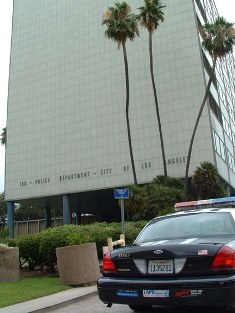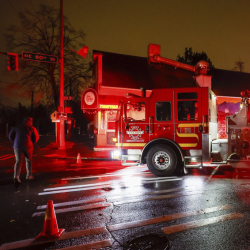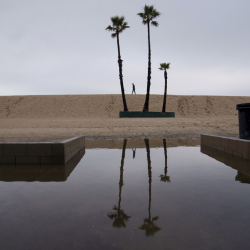 A new law that encourages alternatives to police involvement in school discipline matters was signed by Gov. Jerry Brown this week, just days after the U.S. Department of Justice awarded $44 million to beef up the number of police officers in schools nationwide, including California.
A new law that encourages alternatives to police involvement in school discipline matters was signed by Gov. Jerry Brown this week, just days after the U.S. Department of Justice awarded $44 million to beef up the number of police officers in schools nationwide, including California.
The two approaches to school safety – one encouraging behavioral interventions and conflict resolution practices and the other focusing on increasing police presence – encapsulate the debate about how to keep students safe from harm. The state measure, Assembly Bill 549, which was signed Monday, was designed to offset the impact of a post-Newtown push for police presence in schools, as reflected in the Justice Department grants, said Rubén Lizardo, deputy director of the Oakland-based nonprofit research and advocacy organization PolicyLink, which co-sponsored the bill.
"In the context of what was happening with the escalation of high-profile school violence, we knew at that at the federal and state levels there'd be a rush to a strategy of locking down schools," Lizardo said.
Lobbying for the bill was a way to educate legislators about what Lizardo called the "inadvertent negatives" of police on campus, including what studies have identified as the disproportionate number of arrests of African American and Latino youth and the referral of tens of thousands of students to the juvenile justice system for misdemeanors such as disorderly conduct and minor schoolyard fights.
In the Los Angeles Unified School District, for instance, school police handed out nearly 10,200 misdemeanor tickets to students in 2011 for fighting, daytime-curfew violations and other minor infractions that community groups say might better be handled by school officials or counselors, according to an account published by the Center for Public Integrity, an investigative news organization.
Of those ticketed, 43 percent were children 14 or younger, including an 11-year-old who was ticketed, suspended for one day, handcuffed, driven to the police station, booked, fingerprinted and photographed in a mug shot for what the citation termed a "mutual fight" over a basketball game, according to the account. Research has found that suspending, expelling or referring a student to the juvenile justice system increases the risk that the student will drop out of school and become incarcerated as an adult.
The law signed by Gov. Brown does not limit the responsibilities of police on campus but leaves it up to school districts to decide which student behaviors call for mental health intervention and which require police action. The law simply asks districts to update their school safety plans to clarify the responsibilities of mental health workers, school counselors and police officers in creating safe school environments.
Clarification for campus police
This clarification of roles is also being pursued at the national level through the School Discipline Consensus Project, an effort launched by the Council of State of Governments Justice Center in coordination with the federal Supportive School Discipline Initiative of 2011. The project, which is collecting data on school discipline and will convene experts in school safety, behavioral health and law enforcement, studies the same question that California lawmakers have asked: What, if any, role should local law enforcement play in enforcing a school's code of conduct?
The California law gives a nod to research that has tied a reduction in school suspension and expulsion rates to interventions such as the framework known as Positive Behavioral Interventions and Supports, a system used in an estimated 750 California schools to evaluate programs that teach social and emotional skills. The law encourages schools to place a priority on mental health and intervention services and to create a positive school climate, a loosely defined term that relates to how connected and supported students feel at school.
Advocates praised the law as "a victory for youth and families" that could increase conflict resolution practices and decrease school expulsions and referrals to the juvenile justice system, according to a statement from the Dignity in Schools Campaign, a national coalition of advocacy groups including the Youth Justice Coalition in Los Angeles and the American Civil Liberties Union of Southern California.
In schools, police officers are known as school resource officers but they work for city or county law enforcement departments and are most often paid by federal, state or city funds. Typically, they are assigned to the same school or schools for several years in a row, to strengthen their collaboration with school administrators, teachers and students. Their duties may include teaching the anti-drug curriculum called D.A.R.E. to students, patrolling school grounds and hallways, and intervening in student conflicts, including allegations of bullying.
School resource officers are the fastest growing segment of law enforcement, according to the National Association of School Resource Officers, which estimates that more than 10,000 police officers serve in schools nationwide. The number of officers dramatically increased after the mass shootings at Columbine High School in Colorado in 1999, the same year the U.S. Department of Justice Office of Community Policing Services initiated the "COPS in Schools" grant program, according to a 2011 study published in Justice Quarterly, edited by the Academy of Criminal Justice Sciences. "The increased use of police in schools is driven at least in part by increased federal funding," the study states.
Ensuring student safety
In Washington, U.S. Attorney General Eric Holder promoted increasing police officers in schools as a necessary safety step.
"In the wake of past tragedies, it's clear that we need to be willing to take all possible steps to ensure that our kids are safe when they go to school," Holder said in a news release announcing the funding Sept. 27.
The Justice Department grants include nearly $6 million to fund school police officers in 44 California cities and counties, including funds to put eight more police officers in Modesto schools, two additional officers in Hayward schools and four additional officers in Chula Vista schools.
Officers in schools describe the experience as a way to build relationships with students and contribute to an orderly school environment.
"The positive thing about having officers assigned to high school and middle school is that they get to know the kids," said Sgt. Ozzie Dominguez, spokesman for the Visalia Police Department, which received a $350,000 grant that would bring three police officers to middle schools in the Visalia Unified School District, pending approval from the city council. "They're able not just to respond promptly, but ideally prevent things from happening."
Joseph Grubbs, president of the California School Resource Officers' Association, acknowledged criticism of school resource officers and their potential impact on higher school suspension rates, but he said the officers' primary focus is ensuring the safety of all students.
"I am not a big advocate of suspension," he said. "If a kid does something stupid, we're not going to reward him by suspending him. But if this is a kid who is out of control every single day making this a terrible learning environment for all the other kids, we've got to get him out of there."
A 2010 report published by the U.S. Justice Department and authored by Barbara Raymond, a program director at The California Endowment, points to the lack of solid research showing that school resource officers necessarily make schools safer.
"It will be apparent that despite their popularity, few systematic evaluations of the effectiveness of SROs exist," states the report, "Assigning Police Officers to Schools." The report notes, "Studies of SRO effectiveness that have measured actual safety outcomes have mixed results. Some show an improvement in safety and a reduction in crime; others show no change. Typically, studies that report positive results from SRO programs rely on participants' perceptions of the effectiveness of the program rather than on objective evidence."
This week, the Dignity in Schools Campaign is holding a National Week of Action Against School Pushout that seeks to reframe the dropout issue as a crisis of school discipline practices that are exacerbated by the presence of police on campus.
On Thursday, the campaign showcased "restorative justice" models of discipline and conflict resolution at FreeLA High School, a school for academically at-risk students in Inglewood, and at Augustus Hawkins High School in south Los Angeles. "These approaches focus on building healthy relationships between teachers and students, and treating discipline as a teaching moment, rather than an opportunity to punish and push kids out of school," said the Dignity in Schools Campaign.
Portland and Seattle
Free Subscription to Breaking News
Free Subscription to Breaking News






















































































































































































































































































































































